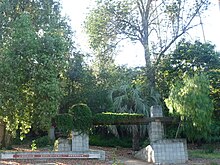California State Polytechnic University, Pomona
The California State Polytechnic University (also Cal Poly Pomona called) is a state university in Pomona in Los Angeles County , State of California . It was founded in 1938. The college is part of the California State University system. Currently (as of 2013) 19,885 students are enrolled here.
prehistory
Today's Cal Poly Pomona has two roots: the Voorhis School for Boys in San Dimas and the Kellogg-Arabian Horse Ranch in Pomona.
The Voorhis School for Boys
The Voorhis School for Boys was established in 1928 by Charles Brown Voorhis (born March 13, 1870, † September 16, 1961) and his son Jerry Voorhis (born April 6, 1901, † September 11, 1984) in San Dimas. It was a home for orphaned male youths with an attached school. The home was funded almost entirely by Charles Brown Voorhis, who had made wealth through his work in the auto industry ( General Motors and Nash Motors Corporation ) and stock ownership.
The effects of the Great Depression in the 1930s - Charles Brown Voorhis had suffered painful losses in his shareholding - made it increasingly difficult to maintain the Voorhis School. When Jerry Voorhis , who ran the school, was elected to the Congress / House of Representatives in 1936 and was time-consuming (he remained a Congressman until 1946), the Voorhis family decided to donate the school to the State of California as a foundation .
In 1938 it became part of the California Polytechnic State University (Cal Poly SLO) in San Luis Obispo and was named California Polytechnic College, Voorhis Unit, San Dimas . A two-year training course in agricultural cultivation techniques was offered. In 1956 this “Voorhis Unit” was merged with the so-called “Kellogg Unit” in Pomona , which had also belonged to Cal Poly SLO since 1949 .
The Kellogg Arabian Horse Ranch , Pomona
In 1925, Will Keith Kellogg , the extremely wealthy founder and owner of the Kellogg Company, acquired an approximately 800 acres (3.2 million m²) ranch in Pomana. In the following years he built up a breed of purebred Arabian horses and acquired offspring of the best bloodlines from England, Saudi Arabia, Egypt and Poland. Because of the excellent breeding herds, the ranch soon became known not only in the USA but all over the world.
In the early 30s, Kellogg wanted to sell the ranch again, but on the condition that the Arabian breed would be preserved. In 1932 he donated the ranch, including around 90 extremely valuable horses, to the University of California . The foundation received an additional donation of 600,000 dollars from Kellogg to ensure that the university would actually continue breeding Arabs. The university was more interested in the donation than in the ranch and Arabian horses and the property was so neglected in the following years that Kellogg tried to return the foundation, which he did not succeed.
When the US armed forces (Remount Service) were looking for a place in the western United States where their cavalry units could be stationed and trained during World War II, the university sold the ranch to the military in 1943. At the end of the Second World War, the last cavalry units of the US Army were disbanded and no more funds were made available for the maintenance of the ranch. On April 2, 1948, the Kellogg Arabian Horse Ranch was incorporated by law into the US Department of Agriculture. However, the ministry also had no funds for the upkeep of the ranch and so it was decided to sell the building and the Arab breeding stock that was still there.
This decision triggered a storm of indignation both at WK Kellogg (or the WK Kellogg Foundation , which was founded in 1930 ), as well as in the public. So in June 1949 - again by law - the ranch was returned to the foundation. California Polytechnic State University in San Luis Obispo showed interest in the ranch as a suitable training facility for agricultural science students. The Foundation then decided to give the ranch to the university as an endowment, and in July 1949 the Kellogg Arabian Horse Ranch became part of California Polytechnic State University, San Luis Obispo (Cal Poly SLO) as California State Polytechnic College, Kellog Unit, Pomona .
Extensive renovations had to be carried out on the buildings, which had been neglected until then. This work continued until 1956. In the meantime, the new administrative unit was looked after from California Polytechnic College, Voorhis Unit, San Dimas (which had been part of Cal Poly, SLO since 1938 / s. O. Voorhis School for Boys ).
Merger and development into a university
In 1956, the "Voorhis Unit" and "Kellogg Unit" were merged, with teaching from now on - due to the larger space - mainly taking place in the "Kellogg Unit" , Pomona. The two combined units operated from then on as an independent college under the name California State Polytechnic College, Kellogg-Voorhis, Pomona .
In 1966 this newly created unit was separated from the Cal Poly SLO and became independent and received university status (Bachelor's and Master's degrees) in 1972. Today California State Polytechnic University, Pomona has around 20,000 students and offers numerous other study options in addition to courses in agriculture.
Sports
The sports teams of Cal Poly Pomona are the Broncos . The college is a member of the California Collegiate Athletic Association .
Web links
Coordinates: 34 ° 3 '22.8 " N , 117 ° 49' 18.3" W.


